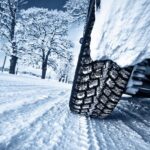There’s nothing like waking up to a fresh blanket of snow whiting out the landscape, but winter weather conditions can also bring plenty of headaches when you climb behind the wheel. As we enter the colder months, it’s a good time to start familiarizing yourself with all the safety-enhancing technology your vehicle has to offer. From four-wheel drive to the full array of modern advanced driver-assistance systems (ADAS) like adaptive cruise control, automatic emergency braking, and more, today’s vehicles are packed with a host of features that can have a noticeable impact on automotive safety.
While they might not be as crucial as some other life-saving technology available, custom drive modes can impact the overall driving experience. These driving modes allow a vehicle to adjust various settings, systems, and components in response to changing conditions and driver preferences, from the fuel-saving eco mode and thrilling sport mode to the handy tow mode that can drastically improve the cargo-hauling utility of a pickup or full-size SUV.
When it comes to winter driving, any driver worth their (road) salt knows how helpful a dedicated snow mode can be. With the ability to dramatically improve control and traction by altering a vehicle’s driving dynamics, snow mode can help drivers get a grip in even the toughest conditions. What is snow mode, when should it be used, and is it a must-have feature for every driver? We’ll address all those questions and more as we take a deep dive into this innovative driver assistance feature.
What Does Snow Mode Do?
At its most basic, snow mode is essentially an enhanced version of traction control designed to be used on slick winter roads. That said, not all snow mode systems are created equal, with each make and model offering its own unique suite of features. Some snow mode systems might offer varying levels of customization with specific settings for deep snow, while others take a more basic approach. Others work in tandem with additional safety and convenience-related systems like hill start assist and hill descent control, so it’s important to review the details of a vehicle’s own snow mode system when you set out to buy your next ride.
While snow mode might differ between vehicles and systems, the technology typically employs four different strategies to improve traction and safety in winter driving conditions. Let’s take a closer look at each of these approaches and learn how a few simple adjustments can make all the difference when facing snow- or ice-covered roads.
Reducing Engine Power
When the white stuff starts to fly, too much power can work against you. Accelerating on a slippery surface can easily lead to wheelspin, when one of the vehicle’s wheels loses traction and starts to rotate faster than the vehicle’s non-powered wheels. Wheelspin can dramatically reduce a driver’s ability to control the vehicle, leading to unresponsive steering and increasing the risk of an accident. Snow mode addresses the dreaded wheel spin by decreasing the engine’s power output, significantly decreasing the likelihood of wheelspin and allowing smoother, more consistent acceleration on snowy roads.

Adjusting Transmission Shift Points
Reducing the engine’s power output isn’t the only way to address excessive wheel spin. Snow mode also adjusts a vehicle’s transmission shift points, giving drivers the opportunity to drive at lower speeds while still taking full advantage of their gearbox. Snow mode will also often allow vehicles to start in second gear to limit power output and reduce wheelspin, which can be particularly helpful when climbing a steep, slick hill.
Redistributing Torque
Sometimes, it’s not about how much torque you have but where that torque is sent. Vehicles equipped with all-wheel drive and snow mode can pull off a neat trick, adjusting torque distribution to send a little extra power where it’s needed most. When you’re plowing through the snow or carving through an icy turn, chances are that all four tires do not provide the same amount of grip. Snow mode improves traction by enabling a vehicle to direct power to the wheels most firmly planted on the ground.
Adjusting Traction Control
Traction control is constantly working behind the scenes to improve safety by helping the wheels match the speed of the road surface. It’s yet another way to control wheelspin, but snow mode allows a vehicle’s traction control system to kick into overdrive by increasing its sensitivity and allowing it to quickly jump into action in the event of a loss of traction. Of course, there are some cases where traction control can start to work against you. If you find yourself mired in a deep snowbank, traction control’s propensity to limit wheelspin can prevent a vehicle from achieving the rocking, back-and-forth motion you employ to free yourself.
When Should You Use Snow Mode?
Like any modern safety system, snow mode is only helpful when it’s actually called into action. The feature may not be right for every driving scenario, but knowing when to employ it can mean the difference between a safe ride and one that ends with a call to roadside assistance or a little impromptu workout with your portable shovel. Generally speaking, snow mode should be activated whenever snow or ice is on the road, though it can also be useful when facing muddy surfaces. Some manufacturers like Ford call this “slippery mode” instead to make that distinction. Snow mode shouldn’t be used when there isn’t any snow or ice on the road, as it can negatively impact a vehicle’s performance efficiency and acceleration response.
While it has its advantages, snow mode might not always be up to the task. The technology can go a long way towards improving traction on slippery roads, but there are limits to its power. If you’re facing a foot of fresh snow or thick ice, no amount of enhanced traction control will make a significant difference. Sometimes, the best way to improve driving safety in tough winter weather conditions is to avoid driving altogether. Hitting the roads during the heaviest period of snowfall or trying to tackle your morning commute before the snow plows have cleared and slated the road is a surefire recipe for a stressful drive. When possible, try to plan your drive around the weather and only venture onto the road when necessary.
Do You Need It?
Snow mode might be a helpful way to ensure safety and improve confidence when tackling tough winter weather conditions, but is it really a make-or-break feature? Many drivers have gotten along fine without snow mode since they first earned their learner’s permit, but that doesn’t mean they’ve been entirely unassisted. Snow mode is ultimately just a specialized form of traction control. While it’s tough to find specific data related to snow mode, research has shown that traction control systems can significantly impact safety.
A 2004 study by the Insurance Institute for Highway Safety (IIHS) showed that traction control systems can reduce the chances of overall crash involvement by as much as seven percent. Traction control systems can also significantly reduce the seriousness of a crash with a 34-percent reduction in fatality. Those compelling statistics have led the government to mandate the inclusion of traction control systems as a standard feature on all vehicles built since 2012. Snow mode isn’t quite as ubiquitous, but it is finding its way into an increasingly larger number of vehicles as of late, particularly the new generation of crossover SUVs.
While ultimately, the answer is no, you don’t need snow mode, it’s also difficult to argue against the potentially life-saving technology. Drivers have been skeptical of almost every safety-related enhancement that’s come down the line, whether it be airbags, seat belts, anti-lock brakes, or backup cameras. However, these features have steadily worked their way into every vehicle on the road and are now seen as an essential part of any vehicle. While snow mode might not be as essential to overall safety, especially for those who live in warmer climates, it can certainly provide some valuable peace of mind.
Snow mode is a great way to improve safety and reduce the chances of a weather-related accident, but it’s no substitute for good driving habits. Driving slowly, avoiding cruise control, clearing your headlights and taillights of snow, and leaving extra space between vehicles can also pay dividends when winter conditions hit. Drivers shouldn’t underestimate the importance of a good set of snow tires. If you live in an area that regularly experiences significant winter snowfall, investing in a set of snow tires can dramatically improve the overall driving experience. Designed to withstand the rigors of winter driving, snow tires are exceptionally good at providing enhanced traction and effectively clearing out any snow or ice that might become packed between the grooves. Finally, drivers should spend a little time getting a feel for how their vehicle handles on winter roads. Practicing in a snowy parking lot or empty stretch of road where you can test the vehicle’s braking response and steering can tell you a lot about how a vehicle might handle when things get slippery. It might seem like a silly excursion, but it can be an important learning experience that could help you avoid a little bumper-to-bumper contact on your next snowy morning commute.



